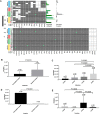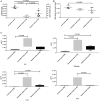Correlation of Moraxella catarrhalis macrolide susceptibility with the ability to adhere and invade human respiratory epithelial cells
- PMID: 35904140
- PMCID: PMC9448378
- DOI: 10.1080/22221751.2022.2108341
Correlation of Moraxella catarrhalis macrolide susceptibility with the ability to adhere and invade human respiratory epithelial cells
Abstract
Recently, the prevalence of macrolide-resistant Moraxella catarrhalis has been reported, especially among Chinese children. The fitness cost of resistance is reported to render the resistant bacteria less virulent. To investigate the correlation between macrolide susceptibility of M. catarrhalis and pathogenicity, the whole genome of 70 M. catarrhalis isolates belonging to four clonal complexes with different macrolide susceptibilities was sequenced. The gene products were annotated with the Gene Ontology terms. Based on 46 extracted essential virulence genes, 19 representative isolates were selected to infect type II alveolar cells (A549 cells). The ability of these isolates to adhere and invade human epithelial cells and to produce cytokines was comparatively analysed. Furthermore, mice were infected with a pair of M. catarrhalis isolates with different pathogenic behaviours and macrolide susceptibilities to examine pulmonary clearance, histological findings, and the production of cytokines. The percentages of annotations for binding, metabolic process, cellular process, and cell were non-significantly different between the macrolide-resistant and macrolide-susceptible groups. The presence of uspA2, uspA2H, pilO, lbpB, lex1, modM, mboIA, and mboIB significantly differed among the four clonal complexes and macrolide susceptibility groups. Furthermore, compared with those in macrolide-susceptible isolates, the adhesion ability was stronger (P = 0.0019) and the invasion ability was weaker (P < 0.0001) in the macrolide-resistant isolates. Mouse experiments revealed that pulmonary macrophages elicit immune responses against M. catarrhalis infection by significantly upregulating the Csf2, Il4, Il13, Il1b, Il6, Tnf, and Il18. Therefore, M. catarrhalis populations exhibited diverse pathogenicity in vitro and in vivo.
Keywords: Moraxella catarrhalis; virulence genes; adhesion; cytokines; invasion; macrolide; pathogenicity.
Conflict of interest statement
No potential conflict of interest was reported by the author(s).
Figures







Similar articles
-
Antimicrobial susceptibility and impact of macrolide antibiotics on Moraxella catarrhalis in the upper and lower airways of children with chronic endobronchial suppuration.J Med Microbiol. 2019 Aug;68(8):1140-1147. doi: 10.1099/jmm.0.001033. Epub 2019 Jul 5. J Med Microbiol. 2019. PMID: 31274402
-
Prevalence and molecular analysis of macrolide-resistant Moraxella catarrhalis clinical isolates in Japan, following emergence of the highly macrolide-resistant strain NSH1 in 2011.J Med Microbiol. 2015 Jul;64(7):708-713. doi: 10.1099/jmm.0.000076. Epub 2015 May 1. J Med Microbiol. 2015. PMID: 25934551
-
High-Level Macrolide-Resistant Moraxella catarrhalis and Development of an Allele-Specific PCR Assay for Detection of 23S rRNA Gene A2330T Mutation: A Three-Year Study at a Chinese Tertiary Hospital.Microb Drug Resist. 2015 Oct;21(5):507-11. doi: 10.1089/mdr.2014.0217. Epub 2015 Apr 29. Microb Drug Resist. 2015. PMID: 25923017
-
Moraxella catarrhalis: from emerging to established pathogen.Clin Microbiol Rev. 2002 Jan;15(1):125-44. doi: 10.1128/CMR.15.1.125-144.2002. Clin Microbiol Rev. 2002. PMID: 11781271 Free PMC article. Review.
-
Virulence determinants of Moraxella catarrhalis: distribution and considerations for vaccine development.Microbiology (Reading). 2017 Oct;163(10):1371-1384. doi: 10.1099/mic.0.000523. Epub 2017 Sep 12. Microbiology (Reading). 2017. PMID: 28893369 Review.
Cited by
-
Comparison of the adherence of nontypeable haemophilus influenzae to lung epithelial cells.BMC Infect Dis. 2024 Feb 12;24(1):188. doi: 10.1186/s12879-024-09085-7. BMC Infect Dis. 2024. PMID: 38347439 Free PMC article.
-
Immune-Mediated Bidirectional Causality Between Inflammatory Bowel Disease and Chronic Periodontitis: Evidence from Mendelian Randomization and Integrative Bioinformatics Analysis.Biomedicines. 2025 Feb 15;13(2):476. doi: 10.3390/biomedicines13020476. Biomedicines. 2025. PMID: 40002889 Free PMC article.
-
The Direct Anti-Virulence but Not Bactericidal Activity of Human Neutrophil Elastase against Moraxella catarrhalis.Int J Mol Sci. 2023 Apr 1;24(7):6607. doi: 10.3390/ijms24076607. Int J Mol Sci. 2023. PMID: 37047578 Free PMC article.
-
Phylogenetic Lineages and Diseases Associated with Moraxella catarrhalis Isolates Recovered from Bulgarian Patients.Int J Mol Sci. 2024 Sep 10;25(18):9769. doi: 10.3390/ijms25189769. Int J Mol Sci. 2024. PMID: 39337257 Free PMC article.
-
Inhibiting F-Actin Polymerization Impairs the Internalization of Moraxella catarrhalis.Microorganisms. 2024 Jan 30;12(2):291. doi: 10.3390/microorganisms12020291. Microorganisms. 2024. PMID: 38399695 Free PMC article.
References
-
- Ventura F, Barranco R, Buffelli F, et al. . Unexpected and sudden death Due to undiagnosed moraxella catarrhalis meningoencephalitis in a 40-day-old infant. Am J Forensic Med Pathol. 2020;41:333–337. - PubMed
-
- National Health and Family Planning Commission Expert Committee on Rational Use of Medicines for Children Pharmaceutical Group . Investigation on the rational use of antibacterial agents by Chinese pediatricians in 2016. Zhonghua Er Ke Za Zhi. 2018;56:897–906. - PubMed
-
- Liu Y, Zhao C, Zhang F, et al. . High prevalence and molecular analysis of macrolide-nonsusceptiblemoraxella catarrhalisisolated from nasopharynx of healthy children in China. Microb Drug Resist. 2012;18:417–426. - PubMed
-
- Liu Y, Xu H, Xu Z, et al. . High-Level macrolide-resistant moraxella catarrhalis and development of an allele-specific PCR assay for detection of 23S rRNA gene A2330T mutation: A three-year study at a Chinese tertiary hospital. Microb Drug Resist. 2015;21:507–511. - PubMed
MeSH terms
Substances
LinkOut - more resources
Full Text Sources
Other Literature Sources
Miscellaneous
